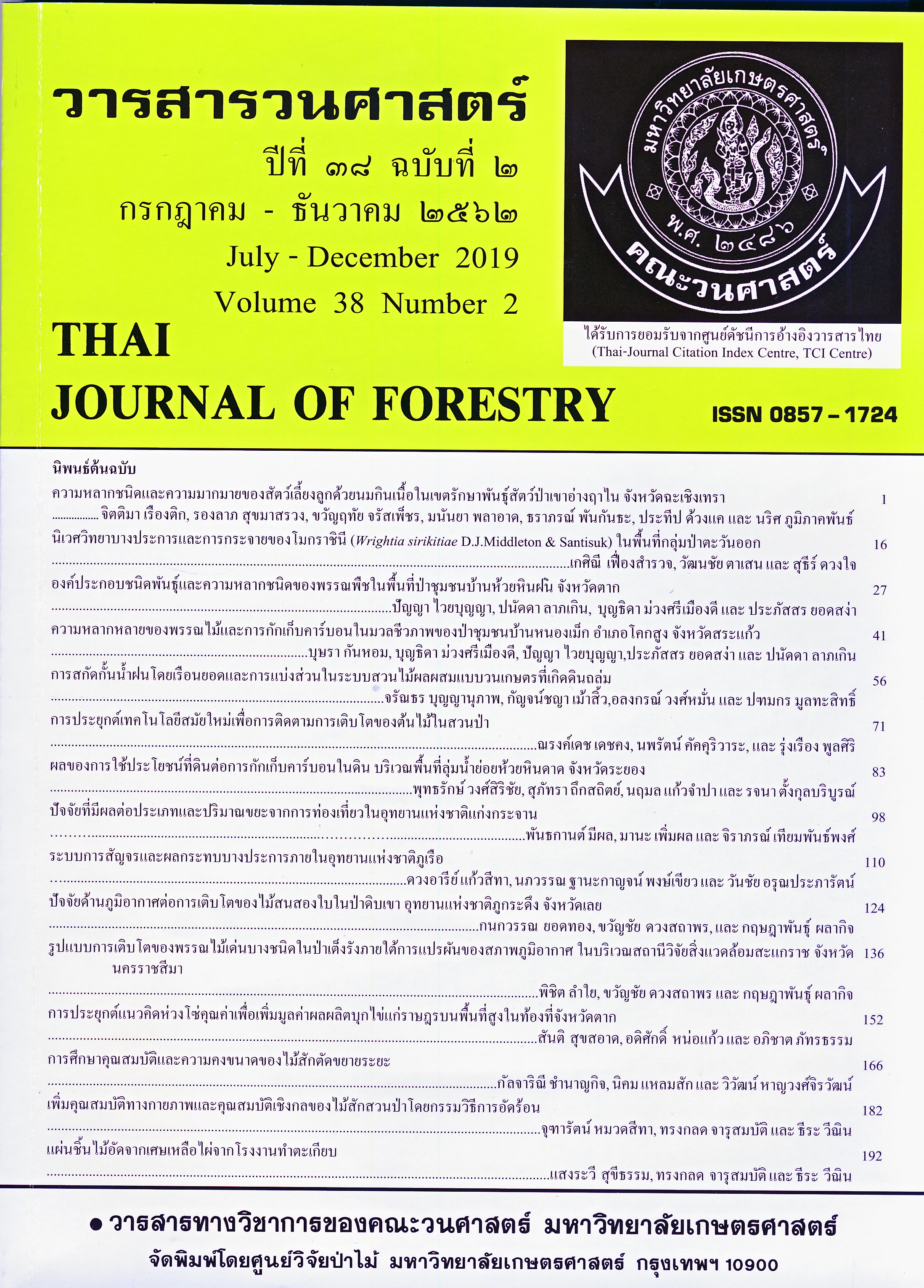ระบบการสัญจรและผลกระทบบางประการภายในอุทยานแห่งชาติภูเรือ
Main Article Content
บทคัดย่อ
การวิจัยครั้งนี้มีวัตถุประสงค์เพื่อศึกษาปริมาณยานพาหนะ ขีดความสามารถสูงสุดในการรองรับได้ของลานจอดรถ ผลกระทบจากระบบการสัญจรต่อประสบการณ์ของผู้มาเยือน และผลกระทบบางประการต่อดินและพืชพรรณในอุทยานแห่งชาติ ภูเรือโดยเก็บข้อมูลปริมาณยานพาหนะที่ผ่านเข้า-ออกพื้นที่และบริเวณลานจอดรถ วัดขนาดพื้นที่ของลานจอด ใช้แบบสอบถามเก็บข้อมูลจากนักท่องเที่ยว และใช้วิธีวางแปลงตัวอย่างแบบมีระบบในการศึกษาผลกระทบต่อดินและพืชพรรณ สำหรับการวิเคราะห์ข้อมูลใช้สถิติเชิงพรรณนา การวิเคราะห์ถดถอยพหุ และการวิเคราะห์ความแปรปรวน ผลการศึกษาพบว่าอุทยานแห่งชาติภูเรือมีปริมาณยานพาหนะเข้าไปใช้ประโยชน์สูงสุดในช่วงวันหยุดนักขัตฤกษ์เฉลี่ย 1,321 คัน/วัน ลานจอดรถภายในอุทยานแห่งชาติภูเรือสามารถรองรับยานพาหนะได้ 746 คัน/รอบ หรือ 842 คัน/ชั่วโมง เมื่อเปรียบเทียบปริมาณการใช้ประโยชน์กับขีดความสามารถในการรองรับได้พบว่าลานจอดรถส่วนใหญ่มีปริมาณการใช้ประโยชน์น้อยกว่าร้อยละ 50 ซึ่งอยู่ในระดับต่ำกว่าขีดความสามารถในการรองรับได้ ยกเว้นลานจอดรถบริเวณลานกางเต็นท์ที่ 2 (ภูสน) ที่มีปริมาณการใช้ประโยชน์มากกว่าร้อยละ 80 และอยู่ในระดับเกินขีดความสามารถสูงสุดในการรองรับได้ สำหรับคุณภาพประสบการณ์ของผู้มาเยือนพบว่าผู้มาเยือนมีความพึงพอใจโดยรวมในการเดินทางอยู่ในระดับสูง โดยมีค่าเฉลี่ยความพึงพอใจต่อคุณภาพอากาศสูงสุดและต่อสภาพผิวถนนต่ำสุด สำหรับผลกระทบต่อดินและพืชพรรณพบว่าบริเวณใกล้ถนนมีค่าความหนาแน่นรวมของดินสูงกว่าในพื้นที่ป่าธรรมชาติเช่นเดียว กับปริมาณของชนิดพันธุ์ต่างถิ่นที่บริเวณใกล้ขอบถนนมีปริมาณสูงกว่าในพื้นที่ป่าธรรมชาติ และเส้นทางจากด่านตรวจที่ 2 (ยอดภูเรือ) ถึงลานกางเต็นท์ที่ 2 (ภูสน) พบการพังทลายของดินอยู่ในระดับผลกระทบรุนแรง
Downloads
Article Details
ข้าพเจ้าและผู้เขียนร่วม (ถ้ามี) ขอรับรองว่า ต้นฉบับที่เสนอมานี้ยังไม่เคยได้รับการตีพิมพ์และไม่ได้อยู่ในระหว่างกระบวนการพิจารณาตีพิมพ์ลงในวารสารหรือสิ่งตีพิมพ์อื่นใด ข้าพเจ้าและผู้เขียนร่วม (ถ้ามี) ยอมรับหลักเกณฑ์และเงื่อนไขการพิจารณาต้นฉบับ ทั้งยินยอมให้กองบรรณาธิการมีสิทธิ์พิจารณาและตรวจแก้ต้นฉบับได้ตามที่เห็นสมควร พร้อมนี้ขอมอบลิขสิทธิ์ผลงานที่ได้รับการตีพิมพ์ให้แก่วารสารวนศาสตร์ คณะวนศาสตร์ มหาวิทยาลัยเกษตรศาสตร์ กรณีมีการฟ้องร้องเรื่องการละเมิดลิขสิทธิ์เกี่ยวกับภาพ กราฟ ข้อความส่วนใดส่วนหนึ่ง หรือ ข้อคิดเห็นที่ปรากฏในผลงาน ให้เป็นความรับผิดชอบของข้าพเจ้าและผู้เขียนร่วม (ถ้ามี) แต่เพียงฝ่ายเดียว และหากข้าพเจ้าและผู้เขียนร่วม (ถ้ามี) ประสงค์ถอนบทความในระหว่างกระบวนการพิจารณาของทางวารสาร ข้าพเจ้าและผู้เขียนร่วม (ถ้ามี) ยินดีรับผิดชอบค่าใช้จ่ายทั้งหมดที่เกิดขึ้นในกระบวนการพิจารณาบทความนั้น”
เอกสารอ้างอิง
Auerbach, N.A., M.D. Walker and D.A. Walker. 1997. Effects of roadside disturbance on substrate and vegetation properties in arctic tundra. Ecological Applications 7: 218-235.
Blake, G.R. and K.H. Hartge. 1986. Bulk density, pp. 363-382. In A. Klute ed. Methods of Soil Analysis, Part 1—Physical and Mineralogical Methods. 2nd ed. Agronomy Monograph 9, American Society of Agronomy—Soil
Science Society of America, Madison.
Charungphan, K., B. Maungsri, N. Kongcheepyun, T. Ruengmak and S. Kongcheepyun. 2015. Species and distribution of invasive alien plants in national park, pp. 170-176. In Proceedings of the 5th Thai forest Ecological Research Network (T-FERN). 16-17 December 2015. Faculty of Forestry, Kasetsart University. Bangkok. (in Thai)
Fogg, G.E. 1997. Park Planning Guidelines. 3rd ed. National Recreation and Park Association, Washington, D.C.
Forman, R.T.T., D. Sperling, J.A. Bissonette, A.P. Clevenger, C.D. Cutshall, V.H. Dale, L. Fahrig, R. France, C.R. Goldman, K. Heanue, J.A. Jones, F.J. Swanson, T. Turrentine and T.C. Winter. 2003. Road Ecology Science and Solutions. Island Press, Washington.
Johnston, F.M. and S.W. Johnston. 2004. Impacts of road disturbance on soil properties and on exotic plant occurrence in subalpine area of the Australian Alps. Arctic, Antarctic, and Alpine Research 36: 201-207.
Lee, M.A., L. Davies and A. Power. 2012. Effects of roads on adjacent plant community composition and ecosystem function: An example from three calcareous ecosystems. Environmental Pollution 163: 273-280
Manning, R., S. Lawson, P. Newman, J. Hallo and C. Monz. 2014. Principles of sustainable transportation in the national park. The George Wright Forum 31: 345-358.
National Park Office. 2008. Handbook 10th Monitoring of Recreation Carrying Capacity in National Park. Department of National Parks, Wildlife and Plant Conservation, Bangkok. (in Thai)
National Park Office. 2019. Amount of National Park Revenue, Tourist, and Vehicles. Available Source: http://portal.dnp.go.th/Content/nationalpark?contentId=11191, February 10, 2019. (in Thai)
Tanakanjana, N., S. Chetamas, D. Emphandhu, N. Pichakum, L. Temtrakul, S. Singhawarawut and S. Ratchakiri. 1998. Handbook for Develop Facilities in Tourism Site to Ecotourism. Forestry Research Center, Faculty of Forestry, Kasetsart University. Bangkok. (in Thai)
White, D. 2007. An interpretive study of Yosemite National Park visitors’ perspectives toward alternative transportation in Yosemite Valley. Environmental Management 39: 50-62.
Withayawongruchi, C. and M. Poopath. 2012. Species and Distribution of Invasive Plants in Kaeng Krachan Forest Complex: Case of Prache Rever Wildlife Sanctuary, Ratchaburi Provience. Division of Wild Fauna and Flora
Protection, Department of National Parks, Wildlife and Plant Conservation, Bangkok. (Mimeographed) (in Thai)
Yamane, T. 1973. Statistics: An Introduction Analysis. 3rd ed. Harper & Row, New York.


